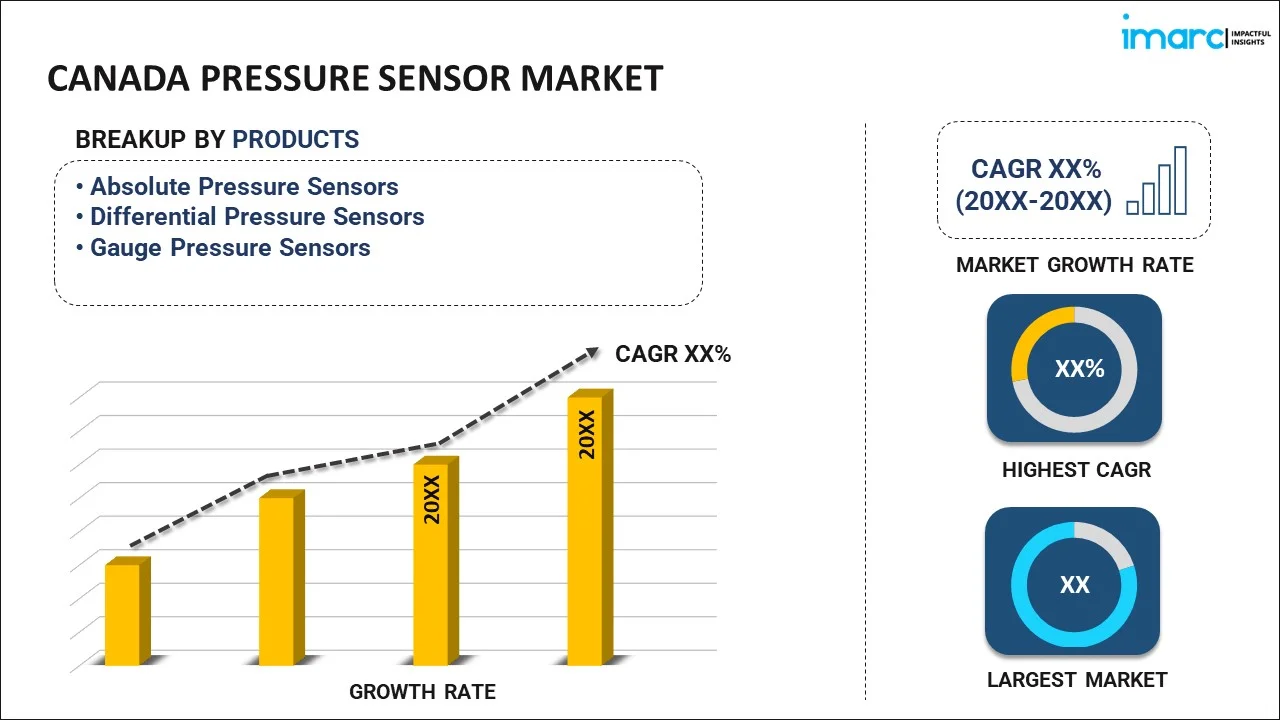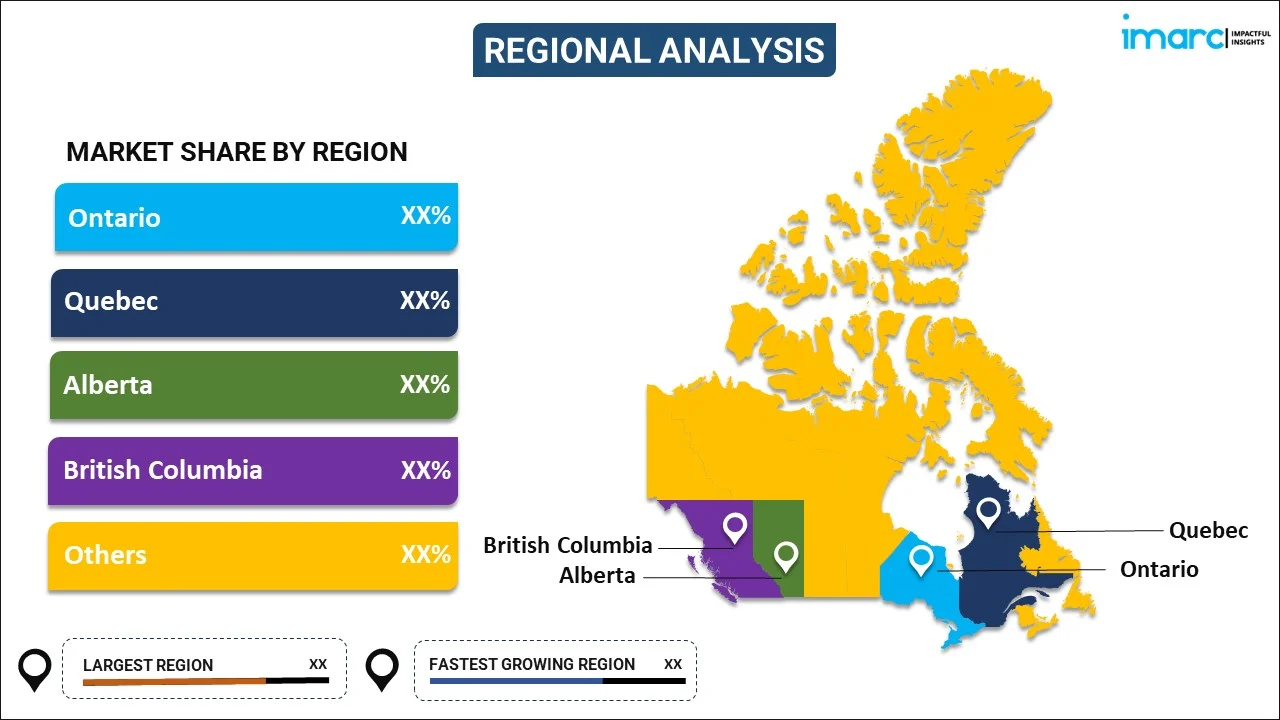
Canada Pressure Sensor Market Report by Product (Absolute Pressure Sensors, Differential Pressure Sensors, Gauge Pressure Sensors), Type (Wired, Wireless), Technology (Piezoresistive, Electromagnetic, Capacitive, Resonant Solid-State, Optical, and Others), End User (Automotive, Oil and Gas, Electronics, Medical, Industrial, and Others), and Region 2024-2032
Canada Pressure Sensor Market Overview:
The Canada pressure sensor market is projected to exhibit a growth rate (CAGR) of 6.50% during 2024-2032. The market in Canada is primarily driven by continual technological advancements enhancing sensitivity, accuracy, and durability, increasing industrial automation for precise monitoring and control, and rising demand in automotive applications for safety, efficiency, and regulatory compliance.
|
Report Attribute
|
Key Statistics
|
|---|---|
|
Base Year
|
2023 |
|
Forecast Years
|
2024-2032
|
|
Historical Years
|
2018-2023
|
| Market Growth Rate (2024-2032) | 6.50% |
Canada Pressure Sensor Market Trends:
Continual Technological Advancements
Canada is making significant progress in pressure sensor technology through continuous innovation to improve sensitivity, accuracy, and durability. Engineers and researchers are developing new materials and improving manufacturing methods to enhance accuracy and dependability in pressure sensing uses. One example is the incorporation of MEMS technology, which has resulted in the shrinking and enhanced efficiency of pressure sensors in sectors like automotive and healthcare. This advancement in technology allows sectors to implement improved and dependable sensing solutions, leading to an increased need for advanced pressure sensors in the Canadian market. With ongoing advancements in technology, sensor capabilities will be further improved, allowing for more advanced applications across various industrial environments.
Increasing Industrial Automation
Industrial automation in Canada is also a key factor driving the need for pressure sensors. The increasing use of automation technologies in various industries like manufacturing, oil and gas, and pharmaceuticals has created a demand for accurate monitoring and control of pressure levels. Pressure sensors are essential for maintaining efficiency, ensuring quality control, and meeting regulations in automated systems. They allow for monitoring pressure changes in real-time, which helps industries improve processes, reduce downtime, and boost productivity. As Canadian businesses adopt Industry 4.0 concepts more, incorporating smart sensors like advanced pressure sensors is not just advantageous but essential for achieving smooth automation and implementing smart manufacturing practices that are efficient and flexible to evolving operational needs. Recent advancements also involve integrating AI-powered analytics to improve predictive maintenance strategies by analyzing real-time pressure data.
Increasing Demand in Automotive Applications
The Canadian automotive industry is seeing a high need for pressure sensors, mainly because of advancements in vehicle technology and strict regulatory standards. Pressure sensors play a crucial role in present-day cars, utilized for tasks like monitoring tire pressure with TPMS, regulating engine systems, and managing emissions. With automakers placing a higher emphasis on safety, efficiency, and environmental impact in vehicles, there is a growing need for precise and dependable pressure sensing technology. Additionally, the move towards electric and autonomous cars requires high-tech sensor technologies to supervise battery pressures, hydraulic systems, and onboard air pressure. This development highlights the significance of pressure sensors in driving automotive advancements and also offers potential for growth for sensor makers and suppliers in Canada.
Canada Pressure Sensor Market News:
- October 31, 2023: Figaro announced the establishment of its Europe Office in Neuss, Germany, on October 1, 2023. The new office aims to enhance local technical support for European customers and distributors, as well as facilitate marketing activities to expand Figaro's presence in the European market. The office is strategically located at Hellersbergstraße 10a, 41460, Neuss, Germany.
- June 5, 2024: ABB Ltd. has secured contracts from Red Eléctrica to supply synchronous condensers in the Canary and Balearic Islands, supporting grid stability during the transition to renewable energy.
Canada Pressure Sensor Market Segmentation:
IMARC Group provides an analysis of the key trends in each segment of the market, along with forecasts at the country level for 2024-2032. Our report has categorized the market based on product, type, technology, and end user.
Product Insights:

- Absolute Pressure Sensors
- Differential Pressure Sensors
- Gauge Pressure Sensors
The report has provided a detailed breakup and analysis of the market based on the product. This includes absolute pressure sensors, differential pressure sensors, and gauge pressure sensors.
Type Insights:
- Wired
- Wireless
A detailed breakup and analysis of the market based on the type have also been provided in the report. This includes wired and wireless.
Technology Insights:
- Piezoresistive
- Electromagnetic
- Capacitive
- Resonant Solid-State
- Optical
- Others
The report has provided a detailed breakup and analysis of the market based on the technology. This includes piezoresistive, electromagnetic, capacitive, resonant solid-state, optical, and others.
End User Insights:
- Automotive
- Oil and Gas
- Electronics
- Medical
- Industrial
- Others
A detailed breakup and analysis of the market based on the end user have also been provided in the report. This includes automotive, oil and gas, electronics, medical, industrial and others.
Regional Insights:

- Ontario
- Quebec
- Alberta
- British Columbia
- Others
The report has also provided a comprehensive analysis of all the major regional markets, which include Ontario, Quebec, Alberta, British Columbia, and others.
Competitive Landscape:
The market research report has also provided a comprehensive analysis of the competitive landscape. Competitive analysis such as market structure, key player positioning, top winning strategies, competitive dashboard, and company evaluation quadrant has been covered in the report. Also, detailed profiles of all major companies have been provided.
Canada Pressure Sensor Market Report Coverage:
| Report Features | Details |
|---|---|
| Base Year of the Analysis | 2023 |
| Historical Period | 2018-2023 |
| Forecast Period | 2024-2032 |
| Units | Million US$ |
| Scope of the Report | Exploration of Historical Trends and Market Outlook, Industry Catalysts and Challenges, Segment-Wise Historical and Future Market Assessment:
|
| Products Covered | Absolute Pressure Sensors, Differential Pressure Sensors, Gauge Pressure Sensors |
| Types Covered | Wired, Wireless |
| Technologies Covered | Piezoresistive, Electromagnetic, Capacitive, Resonant Solid-State, Optical, Others |
| End Users Covered | Automotive, Oil and Gas, Electronics, Medical, Industrial, Others |
| Regions Covered | Ontario, Quebec, Alberta, British Columbia, Others |
| Customization Scope | 10% Free Customization |
| Post-Sale Analyst Support | 10-12 Weeks |
| Delivery Format | PDF and Excel through Email (We can also provide the editable version of the report in PPT/Word format on special request) |
Key Questions Answered in This Report:
- How has the Canada pressure sensor market performed so far and how will it perform in the coming years?
- What has been the impact of COVID-19 on the Canada pressure sensor market?
- What is the breakup of the Canada pressure sensor market on the basis of product?
- What is the breakup of the Canada pressure sensor market on the basis of type?
- What is the breakup of the Canada pressure sensor market on the basis of technology?
- What is the breakup of the Canada pressure sensor market on the basis of end user?
- What are the various stages in the value chain of the Canada pressure sensor market?
- What are the key driving factors and challenges in the Canada pressure sensor?
- What is the structure of the Canada pressure sensor market and who are the key players?
- What is the degree of competition in the Canada pressure sensor market?
Key Benefits for Stakeholders:
- IMARC’s industry report offers a comprehensive quantitative analysis of various market segments, historical and current market trends, market forecasts, and dynamics of the Canada pressure sensor market from 2018-2032.
- The research report provides the latest information on the market drivers, challenges, and opportunities in the Canada pressure sensor market.
- Porter's five forces analysis assist stakeholders in assessing the impact of new entrants, competitive rivalry, supplier power, buyer power, and the threat of substitution. It helps stakeholders to analyze the level of competition within the Canada pressure sensor industry and its attractiveness.
- Competitive landscape allows stakeholders to understand their competitive environment and provides an insight into the current positions of key players in the market.
Need more help?
- Speak to our experienced analysts for insights on the current market scenarios.
- Include additional segments and countries to customize the report as per your requirement.
- Gain an unparalleled competitive advantage in your domain by understanding how to utilize the report and positively impacting your operations and revenue.
- For further assistance, please connect with our analysts.
 Inquire Before Buying
Inquire Before Buying
 Speak to an Analyst
Speak to an Analyst
 Request Brochure
Request Brochure
 Request Customization
Request Customization




.webp)




.webp)












